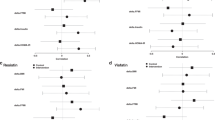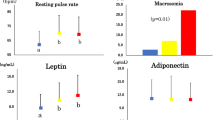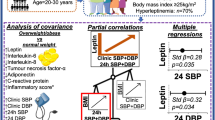Abstract
BACKGROUND: In obese children, plasma leptin is elevated and correlates with the body mass index (BMI). In obese adults, plasma leptin decreases during weight reduction. Since the leptin system changes dynamically in puberty, we asked whether weight reduction in obese adolescents has similar consequences for plasma leptin as in overweight adults. In plasma, a portion of leptin is bound to several as yet uncharacterised proteins. We therefore studied the possible association of leptin with plasma lipoproteins.
SUBJECTS AND METHODS: We measured plasma leptin, lipoprotein cholesterol and apolipoproteins (apo) A-I and B in 34 obese children (age 12.5±1.9 y, relative BMI 165.0±28.1%) before and after three weeks of weight reduction in a dietary camp. Lipoprotein binding of endogenous and exogenously radiolabelled leptin was studied by preparative ultracentrifugation.
RESULTS: Plasma leptin was higher in obese children than in normal weight controls and fell from 16.5±9.8 ng/ml to 10.0±8.6 ng/ml after weight reduction (P<0.001). In multivariate regression, relative BMI and apoA-I were significant predictors of baseline leptin and accounted for 38% (P=0.003) and 15% (P=0.006) of the variance of baseline leptin concentrations in obese children. Only the difference in plasma high-density lipoprotein (HDL)-cholesterol independently predicted the change of plasma leptin that was associated with weight reduction, explaining 29% of the variance of leptin changes (P=0.0032). A substantial portion of both endogenous and exogenously labelled leptin was recovered with HDL isolated by ultracentrifugation.
CONCLUSIONS: We conclude that plasma leptin decreases in overweight children undergoing short term weight reduction. In obese children, plasma apoA-I and HDL-cholesterol are independent predictors of leptin concentrations during weight loss, respectively. In addition, HDLs transport a variable portion of leptin in the circulation.
This is a preview of subscription content, access via your institution
Access options
Subscribe to this journal
Receive 12 print issues and online access
$259.00 per year
only $21.58 per issue
Buy this article
- Purchase on Springer Link
- Instant access to full article PDF
Prices may be subject to local taxes which are calculated during checkout
Similar content being viewed by others
Author information
Authors and Affiliations
Rights and permissions
About this article
Cite this article
Holub, M., Zwiauer, K., Winkler, C. et al. Relation of Plasma leptin to lipoproteins in overweight children undergoing weight reduction. Int J Obes 23, 60–66 (1999). https://doi.org/10.1038/sj.ijo.0800759
Received:
Revised:
Accepted:
Published:
Issue Date:
DOI: https://doi.org/10.1038/sj.ijo.0800759
Keywords
This article is cited by
-
Effect of small doses of dexamethasone on plasma leptin levels in normal and obese subjects: A dose-response study
Journal of Endocrinological Investigation (2003)
-
Metabolic impact of body fat distribution
Journal of Endocrinological Investigation (2002)



